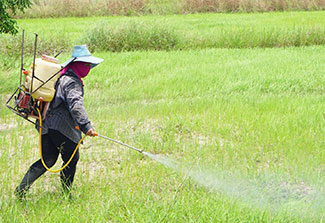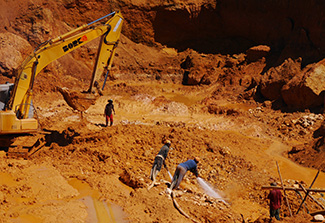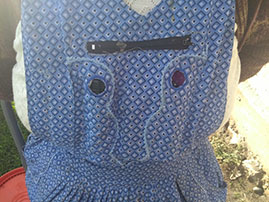Global Environmental and Occupational Health (GEOHealth) hubs train researchers, help address regional priorities
May / June 2019 | Volume 18, Number 3

Photo courtesy West Africa-Michigan GEOHealth hub
The West Africa GEOHealth hub is studying workers
at the Agbogbloshie electronic waste site in Accra,
Ghana, to better understand the health risks of
e-waste recycling, a growing industry.
Nearly a quarter of all deaths worldwide - roughly 12.6 million deaths a year - are attributed to living or working in an unhealthy environment, according to the WHO. Pollution, chemical exposures, climate change and other risk factors are linked to more than 100 types of diseases and injuries. There is an economic impact as well. Work-related illnesses and injuries cost the global economy billions of dollars, as reported by the International Labour Organization.
Low- and middle-income countries (LMICs) bear the biggest health burden. Many people, for example, use solid fuels for cooking and heating, exposing them to pollution in their home, in addition to what they may encounter outside. Agriculture, mining and manufacturing, which have a high risk for illness and injury, are large or growing parts of LMIC economies. While urbanization and industrialization are increasing throughout the developing world, most LMICs don’t have sufficient numbers of experts trained in the types of research that can guide city, factory and agricultural planning, and support policies to protect people from environmental and occupational hazards.
For almost 25 years, Fogarty and its funding partners have been among the few organizations to support environmental and occupational health research training in LMICs. The current program uses a “hub” model, creating regional centers for research and training. The hubs together form a network intended to serve as a platform to coordinate activities and provide a credible source for state-of-the-art knowledge on environmental and occupational health.
Known as
GEOHealth, short for Global Environmental and Occupational Health, the program’s first awards - in the form of cooperative agreements - were issued in 2015. Funding partners invested almost $21 million over five years to establish seven GEOHealth hubs. There are two linked awards for each hub - one to an LMIC institution for research, and the other to a U.S. institution to provide research training.

Photo courtesy Mahidol-UMass GEOHealth hub
The Southeast Asia GEOHealth hub based in Thailand, where
40% of workers have agricultural jobs, is studying whether
some widely used pesticides act as endocrine disruptors.
Each hub addresses health threats that are high priorities in their respective regions. Research topics include outdoor and household air pollution, pesticide exposures, environmental contamination, climate change and electronic waste.
The GEOHealth funding partners reflect the multidisciplinary and global nature of this field of research. Support comes from NIH’s National Cancer Institute (NCI), National Institute of Environmental Health Sciences (NIEHS) and Fogarty; the National Institute for Occupational Safety and Health (NIOSH) within the CDC; Canada’s International Development Research Centre (IDRC); and the Clean Cooking Alliance, which is providing supplemental funding for research and training focused on household air pollution.
“Environmental and occupational risk factors contribute to the growing burden of noncommunicable diseases - risk factors that can be modified,” said Fogarty Director Dr. Roger I. Glass. “The research hubs are designed to develop a critical mass of scientists who understand how the environment triggers disease, identify effective interventions and spur policy changes to improve health.”
“The significant exposures to environmental toxins observed in many regions provide compelling opportunities to answer scientific questions and enhance local capacity to collect and analyze high-quality data to inform research and efforts at amelioration,” according to NCI’s Dr. Robert Croyle.
“Environmental and occupational health problems cross national boundaries, so research and training efforts to understand these problems through our GEOHealth hubs serves not only those affected locally, but all people suffering related issues,” said NIEHS Director Dr. Linda Birnbaum. “Working with our partners to create sustainable research and training hubs in underserved countries benefits everyone.”
“What we do for work has a significant influence on our health and work-related injury and illness continues to be a major contributor to the global burden of disease, disability, and premature death, said NIOSH’s Dr. Sarah Felknor. “The GEOHealth program is an innovative and productive collaboration that leverages investment of funding partners and the needs of academic, research and practice agencies around the world to respond to these difficult issues.”
“GEOHealth succeeds by combining the strengths of multiple research funders,” said IDRC’s Dr. Dominique Charron. “Leveraging each partner’s networks and institutional resources allows us to work more effectively and efficiently, increasing regional collaboration while boosting research coherence and sense-making at each hub.”
Creating the GEOHealth hub model
The GEOHealth program builds on the success of its predecessor, the
International Training and Research in Environmental and Occupational Health program, known as ITREOH. Launched in 1995 with NIEHS and NIOSH as partners, ITREOH funded collaborations between U.S. and LMIC institutions that trained more than 460 scientists at 75 institutions in 43 countries.
In addition to seeding LMIC institutions with expertise, ITREOH produced other notable results. For example, studies of manganese exposure in children in Brazil and Bangladesh linked higher levels of the heavy metal with lower verbal and IQ scores, and more problematic schoolroom behavior. And Chile enacted a comprehensive ban on smoking in public and the workplace following research that found creating smoking and non-smoking areas in bars and restaurants wasn’t enough to protect workers. After 16 years, Fogarty and its partners decided to take a new approach to focus investments in a more concentrated way. The program was reengineered and shifted from training individual scientists to building networked science hubs.
The core of each hub is an LMIC institution that aims to become an internationally recognized “go-to” resource for scientists and decision-makers, as Fogarty program officer Dr. Christine Jessup described it. Another goal in strengthening research at these institutions is to make them attractive for additional funding from NIH or other sources to further enhance sustainability.
These institutions are developing into focal points for collaborative research, data management, training, curriculum development and policy support, in partnership with others in the region. The hubs have established, and will continue to foster, relationships with LMIC government agencies and NGOs to help translate findings into practice and policy.
The cooperative agreements that link LMIC institutions and U.S. collaborators are also key to the model. With the LMIC institution focused on research, and the U.S. partner providing research training to conduct and support sound environmental and occupational health science, the strategy shifts more responsibility to LMIC institutions and builds both their research and administrative capacity. The cooperative agreement mechanism also allows for the involvement of NIH and CDC staff as scientific officers who may provide appropriate assistance and advice in the design of activities, facilitate liaison outreach for partnerships, and help identify and access NIH and other scientific resources.
Forging relationships, expanding reach
The seven hubs are based at institutions in Bangladesh, Ethiopia, Ghana, India, Peru, Suriname and Thailand. Over the past few years, they have been developing their country and regional networks, and expanding their reach in a variety of ways.
The hub at the University of Ghana, for example, wanted to create an inclusive regional network representative of West Africa, which includes French- and English-speaking countries. The team in Ghana, an Anglophone country, formed strategic partnerships with Nigeria, as well as Francophone countries including Benin, Burkina Faso, Cameroon, Côte d'Ivoire and Sénégal.
To expand its reach, the hub in Suriname forged a partnership with the Caribbean Public Health Agency to connect with the Caribbean Community (CARICOM) nations.
In Thailand, where more than 40% of workers have agricultural jobs, the hub’s partners include the Thai Ministry of Public Health’s Bureau of Occupational and Environmental Diseases, and the Thai Department of Agriculture’s Pesticide Research Group.
The hub in Peru has established links with three neighboring countries: Ecuador, Bolivia and Chile. The latter is a high-income country that has become a training site and is an example of a south-south partnership.
Understanding how environment contributes to disease
Air pollution
Nearly 7 million people die prematurely each year from diseases linked to air pollution - both household and outdoor. Given the magnitude of the problem in LMICs, four of the seven hubs have made air pollution research their main project.
Because of rapid urbanization, India has some of the world’s worst air pollution. The
India hub team is developing prediction models to estimate daily exposure to air pollution in two large cities, Chennai and New Delhi. The team is also studying the effects on cardiometabolic health outcomes and characterizing the populations most susceptible to exposure given their socioeconomic status, built environment and occupation. The hub, based at the Centre for Chronic Disease Control in New Delhi, brings together experts from fields that include atmospheric modeling, data science, epidemiology and policy translation. Harvard’s School of Public Health has a linked award to provide training.
While air pollution is a problem in many countries in sub-Saharan Africa, there’s not much data. To fill the gap, the
East African hub is studying both outdoor and indoor air pollution. Researchers from the core institution, Addis Ababa University in Ethiopia, and partner institutions in Kenya, Rwanda and Uganda, are conducting continuous air quality monitoring in the four capital cities and are analyzing hospital records to study the effect of particulate matter on morbidity and mortality. They’re also looking at air quality and its effect on the lung function of school children. The University of Southern California is the U.S. partner for training.

Photo courtesy Bangladesh GEOHealth hub
Researchers with the GEOHealth hub in Bangladesh are
assessing lung function as part of a study of household air
pollution. With nearly 7 million people a year dying prematurely
from air pollution, it is main research project for four of the
seven hubs.
In Peru, the main project is an intervention trial to determine if liquefied petroleum gas (LPG) stoves are a feasible and effective way to reduce household air pollution (HAP). Researchers recruited women who cook with biomass fuels daily and supplied them with LPG stoves. Investigators are studying the effects on pollution and health, as well as what motivates participants to use the new stoves exclusively. The Universidad Peruana Cayetano Heredia is the core institution and Emory University is the lead U.S. partner with the linked award for training.
The
hub in Bangladesh is studying the association between exposure to particulate matter, carbon monoxide and black carbon in HAP, and preclinical markers of cardiopulmonary disease. The team is also investigating whether the pollutants are associated with stable biomarkers of immune dysfunction and inflammation. The effectiveness of LPG stoves is another aspect of the project. The International Centre for Diarrhoeal Disease Research, Bangladesh (icddr,b) is the principal LMIC institution and is partnered with the University of Chicago for training.
Agricultural health
With agricultural health as its focus, the
Southeast Asia hub is investigating whether some widely used pesticides act as endocrine disruptors, which can increase the risk of metabolic syndrome associated with diabetes, stroke, heart disease and other health concerns. The project has expanded to other areas, including the effect of agricultural work on hearing. The hub is based at Thailand’s Mahidol University and has partnered with universities in Indonesia. The University of Massachusetts Lowell is the U.S. awardee for training.
Environmental contamination

Photo courtesy Caribbean GEOHealth hub
The Caribbean GEOHealth hub is studying exposures to
neurotoxicants potentially related to mining and agriculture on
maternal and child health in Suriname, where perinatal
mortality is high.
The
Caribbean hub’s research focuses on neurotoxicant exposures and their impact on maternal and child health. Researchers are studying the effects of environmental contamination related to gold mining and agricultural development. Analysis includes mercury levels in fish and the amount of pesticides found in produce and rice. Scientists are also exploring whether certain minerals and chemicals have a neuroprotective effect. The hub is based in Suriname at Academisch Ziekenhuis Paramibo and Tulane University is its U.S. collaborator for training.
Electronic waste
Recycling discarded computers and other electronics - known as e-waste - is a growing health threat in many LMICs where recycling practices are often primitive and unregulated. Adults and children working at sites or living nearby can come in direct contact with hazardous substances, inhale toxic fumes, or be exposed to contaminants in soil, water and food. The
West African hub is studying e-waste workers and evaluating associations between exposures and the risk of cancer and respiratory problems. The Agbogbloshie e-waste processing center in Accra, Ghana, believed to be one of the world’s largest, is among the research sites providing learning opportunities and bridging fields from epidemiology to chemistry. The University of Ghana is the core institution and the U.S. awardee is the University of Michigan.
Climate change
In addition to their main research projects, three hubs are studying the health impacts of climate change. Bangladesh will explore the effects of temperature change on chronic health outcomes. Peru is investigating its relationship to childhood diarrhea rates. And researchers in East Africa will examine occupational heat stress on workers in key industries, including the flower-growing industry.
Industrialization
In another pilot study, the Bangladesh hub plans to explore the occupational health hazards of industrialization. Through analyzing injury and illness reports, researchers will concentrate on health and safety in the garment industry, which has grown so much over the past few decades that Bangladesh has become the world's second-largest garments exporter.
Building capacity for environmental, occupational health research
More than 120 trainees have completed or are currently receiving training through the GEOHealth program. Cohorts have included clinicians and public health professionals, medical students and undergraduates. They come from academia, government and NGOs. Top training areas are epidemiology, air quality, biostatistics, pregnancy, heavy metals, toxicology, population studies and health policy.


Photos courtesy Dulce Alarcon, Peru GEOHealth hub
With a monitoring device placed in the pocket of an
apron, the GEOHealth Peru team has been studying if
liquefied petroleum gas stoves are a feasible and
effective way to reduce household air pollution.
Each GEOHealth hub provides its own combination of learning experiences. There are opportunities for mentored research training through models that include one-on-one and long-distance mentoring, hands-on experience and journal clubs. There are master’s, doctoral and postdoctoral opportunities, with master’s being the most common. Short courses and workshops in ethics, manuscript production and other subjects also are offered.
Training is linked to research and is producing results in multiple ways. To prepare for air pollution studies in East Africa, for example, LMIC investigators and their teams were taught how to install, use and maintain air quality monitoring equipment and were certified in spirometry to assess lung function. Trainees and scholars also often have roles in the research projects the hubs are conducting as part of the grants. Some hubs have already reported the extended impact of their programs, with trainees and workshop participants sharing the laboratory techniques and other skills they learned with their colleagues.
Together the GEOHealth hubs have produced more than 30 publications, with over a third including trainees as authors and the majority including at least one LMIC author. And there are other measures of success. For example, the hub in Peru launched a master’s program in environmental health and awarded five scholarships to members of the first cohort of trainees. Ghana also has started a similar master’s program at the Kwame Nkrumah University of Science and Technology. Nine trainees in the Caribbean hub are enrolled in a new Ph.D. program at Anton de Kom University of Suriname, and 97% of the trainees in the 2014-2016 cohorts who completed the master’s in public health program got jobs in the field.
Plans for future growth
The hubs continue to form new relationships in their regions to help further their research, provide more training opportunities and inform practice and policies. Now that investigators have had time to solidify their regional roles, they’ve started collaborating across the network. A workshop on air pollution, climate and health hosted by the India hub was attended by members of the teams in West Africa and Bangladesh. Participants from India, Bangladesh and Peru joined colleagues in East Africa for a hands-on workshop on indoor air pollution research. In addition, the Suriname hub invited trainees from other hubs to attend workshops it has held.
Looking ahead, the funding partners reviewed progress and have developed a
program concept that was presented to Fogarty’s advisory board and posted online in February 2019.
More Information
To view Adobe PDF files,
download current, free accessible plug-ins from Adobe's website.